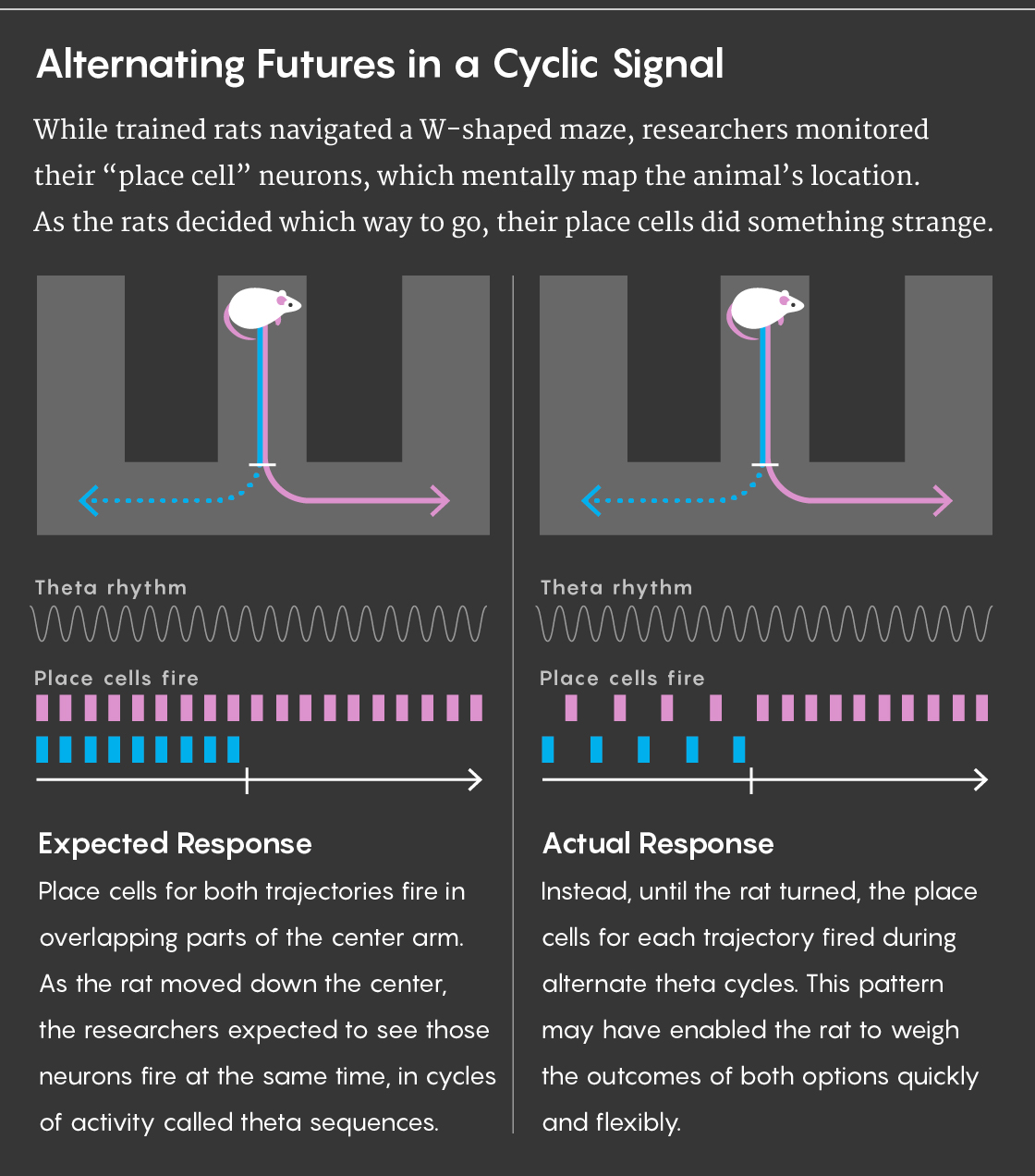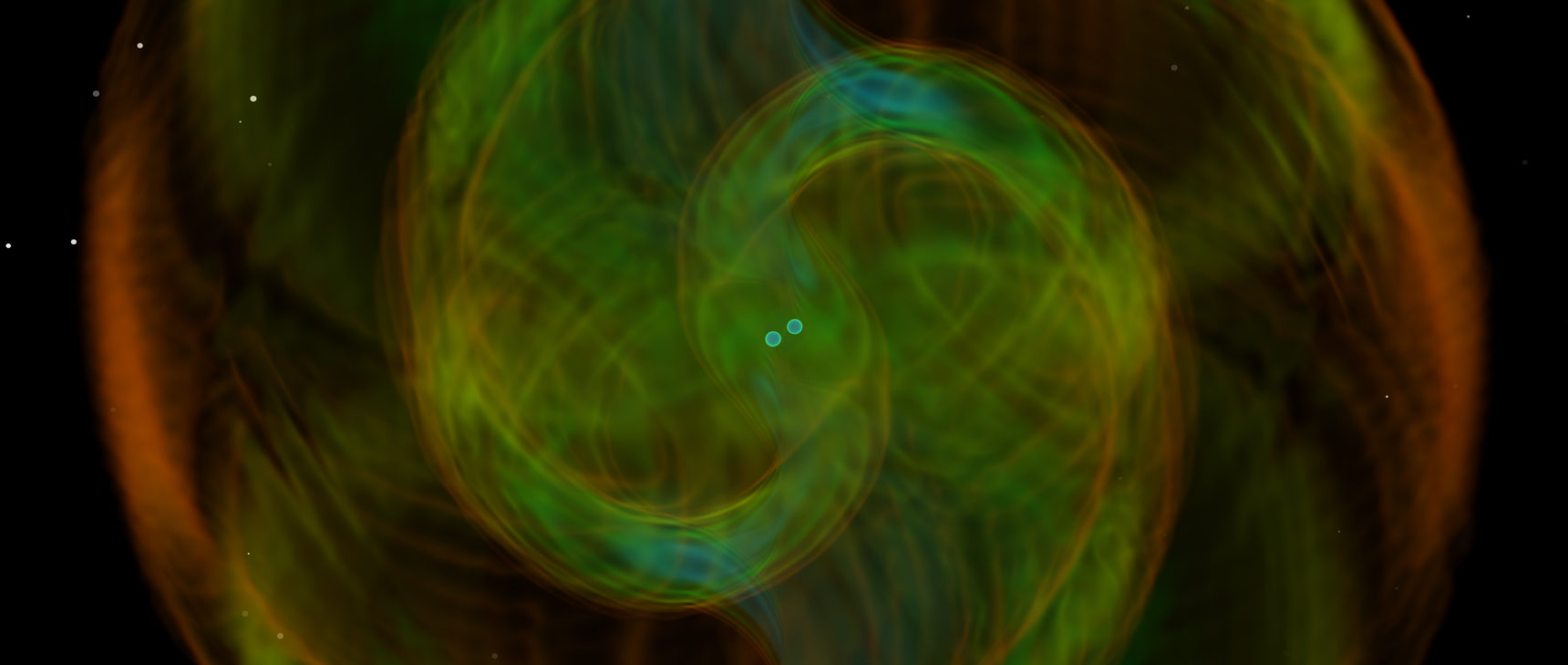In Brain Waves, Scientists See Neurons Juggle Possible Futures

When the brain is considering multiple courses of action, it can represent them as rapidly alternating signals that align with individual cycles of certain brain waves. That process packages the scenarios together but also keeps them distinct.
Introduction
Decisions, decisions. All of us are constantly faced with conscious and unconscious choices. Not just about what to wear, what to eat or how to spend a weekend, but about which hand to use when picking up a pencil, or whether to shift our weight in a chair. To make even trivial decisions, our brains sift through a pile of “what ifs” and weigh the hypotheticals. Even for choices that seem automatic — jumping out of the way of a speeding car, for instance — the brain can very quickly extrapolate from past experiences to make predictions and guide behavior.
In a paper published last month in Cell, a team of researchers in California peered into the brains of rats on the cusp of making a decision and watched their neurons rapidly play out the competing choices available to them. The mechanism they described might underlie not just decision-making, but also animals’ ability to envision more abstract possibilities — something akin to imagination.
The group, led by the neuroscientist Loren Frank of the University of California, San Francisco, investigated the activity of cells in the hippocampus, the seahorse-shaped brain region known to play crucial roles both in navigation and in the storage and retrieval of memories. They gave extra attention to neurons called place cells, nicknamed “the brain’s GPS” because they mentally map an animal’s location as it moves through space.
Place cells have been shown to fire very rapidly in particular sequences as an animal moves through its environment. The activity corresponds to a sweep in position from just behind the animal to just ahead of it. (Studies have demonstrated that these forward sweeps also contain information about the locations of goals or rewards.) These patterns of neural activity, called theta cycles, repeat roughly eight times per second in rats and represent a constantly updated virtual trajectory for the animals.
But as Frank and his team have now found, when an animal is about to act, the neural activity associated with the theta cycles pings back and forth between different possible future paths — not just to make predictions about what’s to come, but as a kind of high-speed, back-and-forth taste test from a buffet of upcoming courses of action.
Alternating Scenarios in the Brain Waves
The researchers trained rats to take alternating routes through a W-shaped maze while electrodes recorded from their place cells. The animals ran through the center arm of the maze, then turned either left or right. But as the rodents approached the point where they had to decide which way to turn, the scientists noticed something odd about the behavior of their place cells.
The rats had place cells that fired in the center arm of the maze just before (and as) they turned left, and others that fired just before (and as) they turned right. It seemed logical that as a rat approached the turning point, both sets of cells would sometimes fire together: In that region of the maze, the cells’ joint activity would reflect the animal’s current position. But that never happened.
Instead, the cells took turns firing. It was as if, before the animal committed to a route, its hippocampus processed both the “left” and “right” options for the locations it would face in the future by alternating between them — and always keeping them distinct.
“The brain was working hard to keep these things apart,” Frank said. “The question was why.”
Previous work by David Redish, a neuroscientist at the University of Minnesota, and the late Adam Johnson showed similar kinds of back-and-forth sweeps through potential futures in the place cells of animals navigating mazes. But those changes seemed to be associated with more deliberative actions, and the pair did not investigate whether the “left” or “right” representations appeared randomly or more systematically.
In contrast, the alternations that the UCSF team identified were precisely aligned with every other cycle of the theta rhythm. The hippocampus generated a representation of the left-turning choice during one cycle, then switched to the right-turning choice for the next one. The scenarios didn’t always alternate perfectly throughout the experiment — occasionally the same one would persist for a few cycles — but the structure in the signals was undeniable. The 125-millisecond sequences seemed to segregate the brain’s different hypotheses about the future into a continuous and consistent overall framework.

Lucy Reading-Ikkanda/Quanta Magazine
“What is astonishing here is the regularity. It’s quite incredible,” said György Buzsáki, a neuroscientist at the New York University School of Medicine who did not participate in the new research. “It’s a one-to-one relationship: One cycle is left, one cycle is right, then left, then right.” The advantage of this highly structured arrangement could be that each “what if” scenario gets tested in a balanced, ordered way, he said.
When Frank and his colleagues looked even more closely at neural activity during the theta rhythms, they found that the first part of each cycle corresponded to where the rat currently was, and the second part showed the left or right alternative. The whole pattern looked something like: current location, possibility of going left, current location, possibility of going right, and repeat.
Keeping All Options Available
Other intriguing patterns also emerged from the data. The researchers found, for instance, that the theta cycles not only flip-flopped between the left-right possibilities facing the rat in the maze, but that sometimes individual cycles could include the possibility of its reversing its route. That finding was puzzling, because it didn’t seem like an option that the rat needed to be considering at that moment.
That fact argues against the idea that the hippocampus is simply predicting what the animal will encounter next, according to Kenneth Kay, a postdoctoral researcher at Columbia University and the first author of the Cell paper. “It suggests that the cycle structure is a potentially universal way of relating the various things the hippocampus can encode.”
In this case, Frank said, “it looks like an explicit representation of thinking, ‘If I were going the other way, what would happen, and is it worth turning around?’”
The theta rhythm therefore seems to have a more general purpose when it comes to encoding hypotheticals. Each cycle “contains particular content,” said Mark Brandon, a neuroscientist at McGill University who did not participate in the study. “It might be ‘turn left’ or ‘turn right.’ But in broader terms, it could be that a particular memory, or a particular event that has happened, is encoded in these 125-millisecond chunks provided by the theta oscillations.”
Redish, who was not involved in the new research, agreed. “It’s not just representing space, but some sort of episodic structure,” he said. “It’s really about considering your options.”
Perhaps, the researchers say, the theta cycle is a fundamental computational unit that the hippocampus uses to survey such abstract choices. Most of the time, its content is likely to be based on experience, and it may allow the animal to respond quickly and flexibly to a changing environment — to escape from a predator, say. But “our work also indicates that it doesn’t necessarily have to help us in any immediate or super obvious way in the future,” Kay said. “It might play a role in creativity, in generative or imaginative processes more broadly.”
That possibility positions the hippocampus as a brain region that doesn’t just aid decision-making by means of its memory-related functions. Rather, it should be viewed as a learning structure, something that generates and samples from imagined futures, simulating options for other brain areas to evaluate and act on. The theta cycles seem to be a clear entry point to unraveling how that works.
The fraction-of-a-second windows might also be crucial for understanding other cognitive processes or neurological conditions. Often, studies of neural processes average cell activity over the course of a trial; the work by Frank and his colleagues demonstrates the importance of parsing information that’s packaged at much faster timescales.
The researchers are now examining the mechanism that gives rise to the alternating patterns they observed, and how that activity affects other parts of the brain during decision-making. They’re also running maze experiments that involve more than two alternative scenarios. While brain rhythms in rodents differ from those in humans, the researchers hope that their findings will hold true for other species, too.
“We’re only scratching the surface of understanding the fine timescale structure of cognition and imagination,” Kay said. “It’s fun to think about.”
Editor’s note: The work by Loren Frank is funded in part by the Simons Foundation, which also funds this editorially independent magazine.



